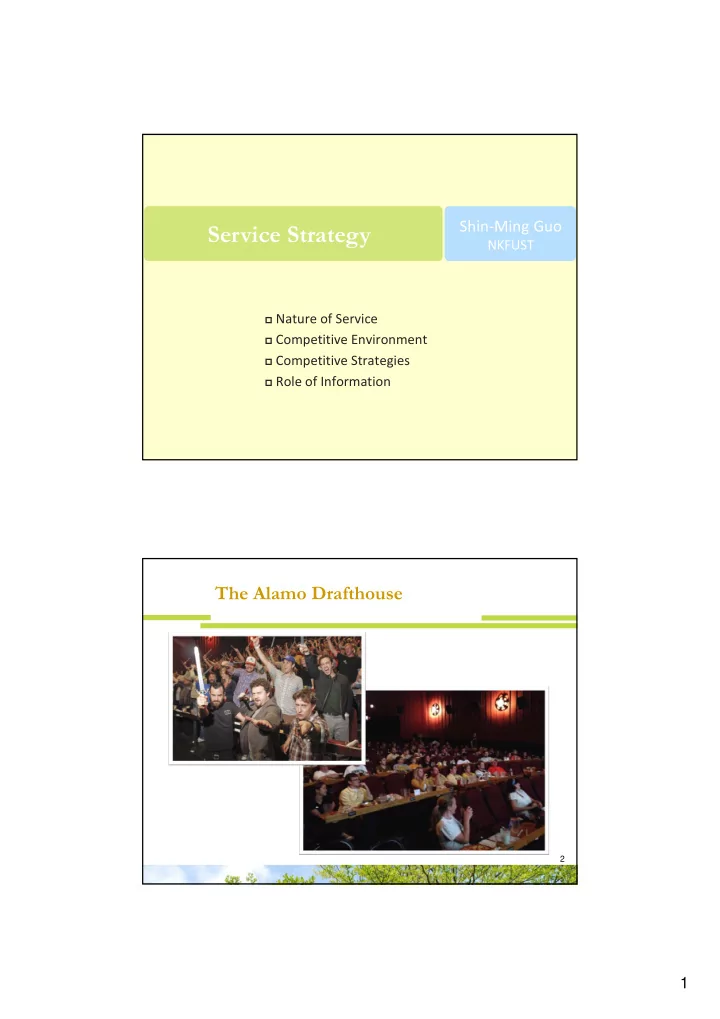

Shin ‐ Ming Guo Service Strategy NKFUST Nature of Service Competitive Environment Competitive Strategies Role of Information The Alamo Drafthouse 2 1
Case Questions Define the service concept. Identify the target market. What is the service winner? Describe the service package. What are the weakness and threats? I. Nature of Service Customer Participation : attention to facility design, opportunities for co ‐ production, concern for customer and employee behavior Simultaneity : opportunities for personal selling, interaction creates customer perceptions of quality Perishability : cannot inventory, opportunity loss of idle capacity, need to match supply with demand Intangibility : creative advertising, no patent protection, importance of reputation Heterogeneity : customer involvement in delivery process results in variability 4 2
Services: Nontransferrable Ownership Type of Service Customer value Examples Goods rental Obtain temporary right Vehicles, tools, furniture, to exclusive use equipment Place and space Obtain exclusive use of Hotel room, seat on rental defined portion of a airplane, storage unit larger space Labor and Hire other people to do Car repair, surgery, expertise a job management consulting Physical facility Gain admission to a Theme park, camp ground, usage facility for a period of physical fitness gym time Network usage Gain access to Electric utility, cell phone, participate internet 5 Competitive Environment of Services Relatively Low Overall Entry Barriers Economies of Scale Limited Erratic Sales Fluctuations No Power Dealing with Buyers or Suppliers Product Substitutions for Service High Customer Loyalty Hobby or job satisfaction High Exit Barriers 6 3
II. Service Strategy: Cost Leadership There is usually a segment of the market that buys solely on the basis of low price . Standardizing a Custom Service (fast haircut) Reducing the Personal Element in Service Delivery (promote self ‐ service) Reducing Network Costs (hub and spoke) Taking Service Operations Off ‐ line (drop ‐ off/pick ‐ up) 7 Service Strategy: Differentiation Differentiation in service means being unique in brand image, technology use, features, or reputation. Making the Intangible Tangible (complimentary towels) Customizing the Standard Product (Burger King) Reducing Perceived Risk (service guarantee) Giving Attention to Personnel Training (Southwest) Controlling Quality 8 4
Service Strategy: Focus Cost and differentiation for a particular target market , not the entire market. Buyer Group: (USAA insurance and military officers) Service Offered: (Shouldice Hospital and hernia patients) Geographic Region: (neighborhood restaurant) Target market could be too small. 9 How Customers Select a Service Provider Price (Quality surrogate) Availability (24 hour ATM) Speed (Avoid excessive waiting) Convenience (Site location) Dependability (On ‐ time performance) Personalization (Know customer’s name) Quality (Perceptions important) Reputation (Word ‐ of ‐ mouth) Safety (Air travel) 10 5
Winning Customers in the Marketplace Service Qualifier : To be taken seriously a certain level must be attained on the competitive dimension, as defined by other market players. – Examples are cleanliness for a fast food restaurant or safe aircraft for an airline. Service Winner : The competitive dimension used to make the final choice among competitors. – Examples are price or reputation. 11 Strategy: Sushi bar vs. Sushi train 12 6
Southwest Airlines Selected routes Limited Service between midsize cities Lean and effective Standardized Productive flight crews 737 aircraft ground crews Frequent, High reliable departures aircraft utilization Consistent Quality, Low Cost 13 Strategic Service Vision Service Delivery Operating Strategy Service Concept Target Market System Segment • Fun cabin • Quick turnaround • Short flights with • State of Texas atmosphere to at gate results in frequent residents differentiate high utilization of departures • Business service aircraft • Serve peanuts & traveler who • Use only Boeing • No assigned soft drinks only drives because 737 aircraft to seating rewards of inadequate • Use of inner ‐ city control punctuality and service or low traffic maintenance & promotes on ‐ time airports avoids • Inexpensive operating costs performance congestion family travel on • Hire cabin crew weekends • Carry ‐ on luggage based on attitude 14 7
III. The Service Package Supporting Facility : The physical resources that must be in place before a service can be sold. Facilitating Goods : The material consumed by the buyer or items provided by the consumer. Information : Operations data or information that is provided to enable efficient and customized service. Explicit Services : Benefits readily observable by the senses. The essential or intrinsic features. Implicit Services : Psychological benefits or extrinsic features which the consumer may sense only vaguely. 15 Designing a Service Package 8
Criteria for Evaluating the Service Package 17 The Service Process Matrix Degree of Interaction and Customization Low High Service Factory Service Shop * Airlines * Hospitals Low * Trucking * Auto repair * Hotels * Other repair services * Resorts & recreation Degree of labor Intensity Mass Service Professional Service * Retailing * Doctors High * Wholesaling * Lawyers * Schools * Accountants * Retail banking * Architects 18 9
19 IV. Competitive Role of Information Online (Real time) Offline (Analysis) Creation of barriers to Database asset: entry: External Selling information (Customer) Reservation system Development of services Frequent user club Micromarketing Switching costs Revenue generation: Productivity enhancement: Internal Yield management Inventory Status (Operations) Point of sales (POS) Data envelopment analysis (DEA) Expert systems 20 10
Using Information to Categorize Customers Coding grades customers on how profitable their business is. Routing is used by call centers to place customers in different queues based on customer code. Targeting allows choice customers to have fees waived and get other hidden discounts. Sharing data about your transaction history with other firms is a source of revenue. 21 Limits in the Use of Information Anti ‐ competitive (membership, frequent flyers) Fairness (yield management) Invasion of Privacy (selling database) Data reliability (credit report) 22 11
Recommend
More recommend